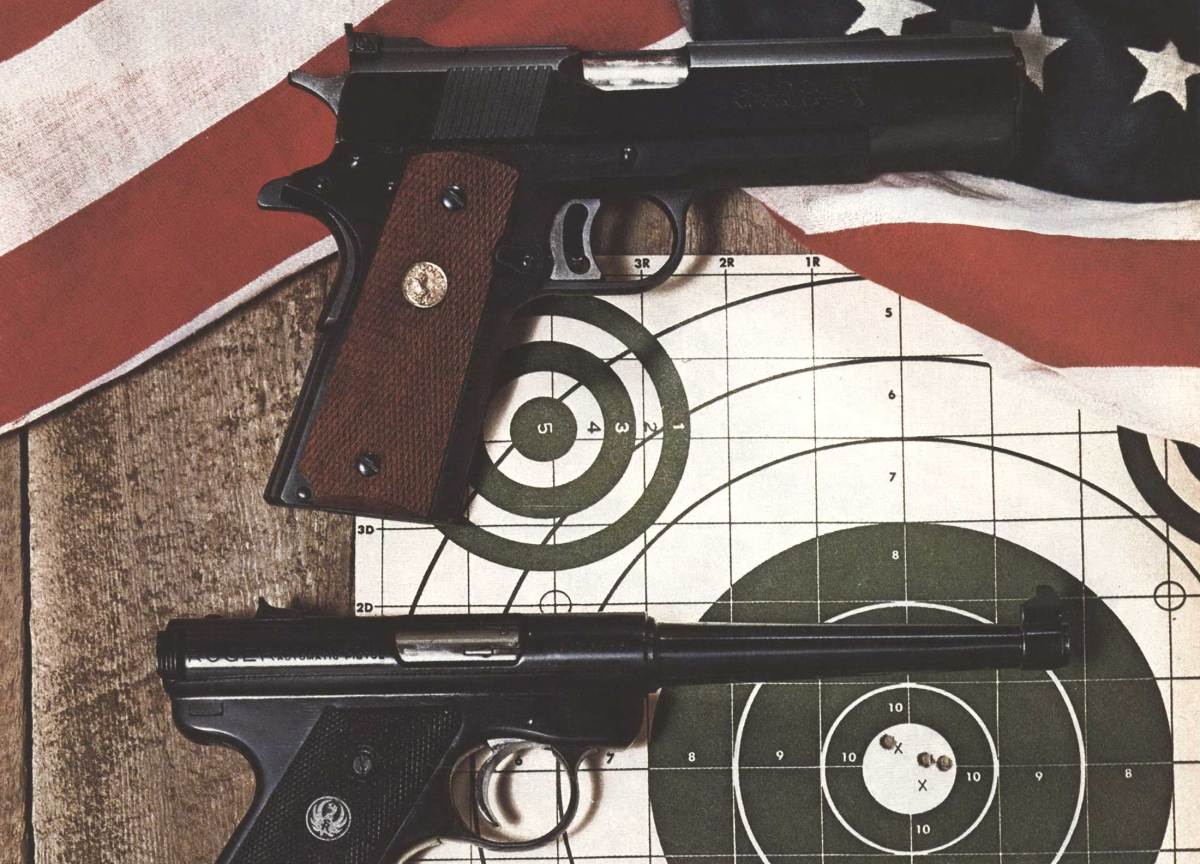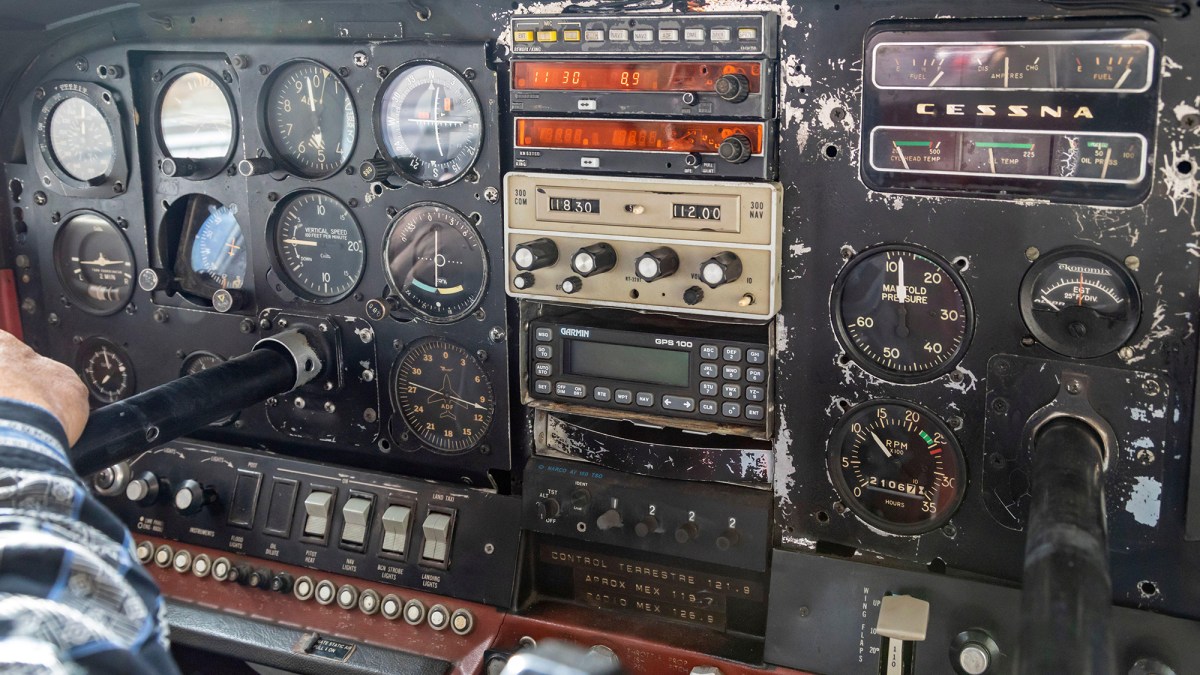Jim Carmichel’s 9 Greatest American Guns

This story was originally published in the November 1980 issue of Outdoor Life.
Selecting the greatest American guns, like choosing the most beautiful women or finest racehorses, is bound to cause all sorts of strong reactions. There will be some nods of approval for my choices, but there will also be a great deal of fistwaving disagreement. Everyone has a favorite model that suits him better than any other. It may be more accurate, more beautiful, easier to shoot or just luckier than any others. It simply has to be the greatest gun in the world.
What criteria should be used to determine whether a gun is truly outstanding? Great workmanship? Could be, but many finely made guns have been inaccurate, unreliable and poorly designed. Should we judge guns by quality of design and engineering? Not always. The World War II “grease gun” was an ingenious utilitarian design, but very few shooters have an overwhelming desire to possess one.
Perhaps we should judge guns by their beauty and the legends they have engendered. Some enthusiasts do.
The guns I have selected are great not for any one reason, but in each case, the gun had a profound effect on gun making and shooting. My original list of some 20 nominations was finally reduced to nine final choices. I discussed the final list with several leaders in the fields of arms making and design. There were, of course, dissenting opinions and requests to add other models. All in all, though, there was strong agreement that these nine are great ones.
These guns all were produced after 1875, and some are still in production. My intent is to discuss fairly modem guns that are still available to modem hunters and target shooters, even if some of them must now be bought secondhand.
The date 1875 eliminates such classics as the early Colt revolvers and Pennsylvania long rifles that are well known and have been celebrated as classics for many years. These nine are all factory guns. I deliberately limited myself to mass-produced firearms because the greatest American contribution to gun making has been the development of mass-production methods that provide arms well within the reach of the average man. Some of the individual guns pictured here are profusely embellished with engraving and fine checkering, but in every case, a moderately priced version was or still is made.
Sometime I’m going to write a column on supposedly great guns that really were misbegotten flops. At that time, I’m sure I’ll provide answers to many questions about why some very popular firearms are not included here. There are good reasons.
Model 1886 Winchester
One has only to see the workmanship and feel the silky smoothness of a Winchester Model 1886 lever-action rifle to realize that it has to be one of America’s best. But Winchester has made some 17 different models of lever-action rifles. What makes the 1886 the greatest?
From the standpoint of craftsmanship it represented the apex of that unique American phenomenon — mass craftsmanship. Each Model 1886 was a superbly handcrafted piece, but by combining skilled hand labor with newly developed mass-production techniques, Winchester was able to make the 1886 by the thousands at moderate prices. In all, some 160,000 were made between 1886 and 1935.
Before the development of the 1886, designed by no less a genius than John M. Browning, lever-action rifles were made stronger simply by making them more massive. The 86 achieved great strength through vertical sliding bolts that rigidly interlocked the bolt with the receiver. The resulting high strengthto-weight ratio made it possible for the Model 1886 to fire such powerful cartridges as the .50/110 Express. The Model 1886 was chambered for 10 different large-caliber cartridges.
The 1886 rifle was the first modem lever-action rifle. From 1886 until 1955, all lever-action rifles introduced by Winchester, including the all-time best selling Model 1894, had mechanical features first laid down and proved in the great Model 86.
Browning 5-Shot Autoloader
Belgium’s Fabrique Nationale, Remington and, later, Savage all made shotguns on the original John Browning patent. This gun (top) was originally to have been built by Winchester, which had bought many other Browning patents. But by an odd twist of fate, John Browning took his autoloading shotgun design to Belgium instead. European production began in 1900, followed in the United States by Remington in 1905. Savage offered its version, the Model 720, in 1930. The design has proved so popular that it is still being manufactured and sold by Browning Arms with very few changes from the original 1900 version.
The gun’s true greatness, however, is best illustrated by the effect it had on the shooting world. Think automatic shotgun, and you just naturally think of the distinctive humpback Browning profile. Just as the Model 97 proved that the pump-gun idea was viable, the five-shot Browning proved the selfloader concept. In the long run, today’s smooth-working gas-operated autoloaders may prove to be the better system, but the old recoil-operated humpback showed us what self-loading was all about and proved that an autoloader could be a dependable firearm.
Browning Superposed
Though it was never actually manufactured in the United States, Americans lay claim to this immortal gun because it was patented by John Browning in 1923. He went to Belgium to supervise its production. No one who has ever handled a Superposed (middle) has to be told that it is a great gun, but seldom do we pause to consider just how great it is. It was the crowning jewel in John Browning’s collection, the ultimate demonstration of the full range of his genius. Here was a designer and maker of fast-firing rifles, shotguns and pistols who, in one dazzling stroke, showed that he could equal Europe’s most elegant guns.
This was astonishing in an American designer, whose other guns are noted for functional beauty. A Colt 1911 autoloading pistol, for instance, is beautiful only to a man who loves a tough, thoroughly dependable handgun. Much the same can be said of Browning’s Model 97 Winchester shotgun. The Superposed is a tough gun, too, but the basic design is beautiful.
In fact, the Browning Superposed more than equaled Europe’s best: it set the style for all over/unders to follow and by itself made the world conscious of the over/under double.
Model 97 Winchester Shotgun
America is the land of the pump-action shotgun, and we’ve made some great ones. The Ithaca Model 37, Remington Model 31, and Model 870 and the Winchester Model 12 are all better than the old 97, so why is it the greatest?
The answer is simple. If it had not been for the Model 97 (bottom) other pump guns might never have been made. The 97 is the gun that proved that a slide-operated, repeating shotgun mechanism is a valid proposition in terms of performance, reliability and shooter acceptance. This gun was the fork in the road that veered American hunters away from the double-barrel tradition and got many of us into the habit of using single repeaters.
The 97 was not the first pump gun. Spencer and Roper made slide-operated shotguns years before, and Winchester’s Model 93 preceded the 97. But the 97 had it all: fine workmanship, smooth functioning, utter reliability, and it was the deadliest, most efficient smoothbore hunters had ever put to their shoulders. It was so good, in fact, that between 1897 and 1957, shooters bought 1,024,700 Model 97s. Some 97 s with short barrels and bayonets were used by the U.S. Infantry in World War I.
Model 1911 Colt .45 Auto
Ex-GIs who remember it as a bellowing, hard-to-shoot sidearm may find it hard to rank the Model 1911 .45 autoloading pistol among America’s greatest guns, but even those experts who hate the hard-kicking .45 are forced to admit the superiority of its design, performance and reliability. Its impact on autoloading pistol design has, in fact, been so overwhelming that an autoloader that does not in some way copy the Model 191 1 is the exception. It is so good that a number of gun makers in South America and Europe as well as the United States actually copied the original design in detail externally as well as internally.
Though best known in its original .45 ACP caliber, the Model 1911 design has seen service in such calibers as 9mm, .38 Super, .38 Special, even .22 Rimfire.
Designed and patented by John M. Browning, the 191l Colt auto was intended as a military and police sidearm, but, in more recent years, it has become the mainstay in NRA target competition and even in some forms of Olympic shooting.
GIs who couldn’t hit a barn door with the old .45 in basic training may be surprised to hear that special match versions of the old auto are among the world’s most accurate centerfire handguns. In this capacity, it continues to be the most used and desired sporting handgun in America. The Gold Cup target model is shown opposite.
The 1911 Colt autoloader is not just a great gun, it is probably the greatest handgun of all time.
.22 Ruger Autoloader
Born in a wooden shack near the Southport, Connecticut, railway depot, this brainchild of William Ruger didn’t show all that much promise back in 1949. Its stamped and welded frame was a far cry from the machined products favored by shooters, and the profile was so similar to the famous German Luger that one wondered if there really was a guy named Ruger. There was, and he wasn’t kidding about making guns.
When the first Ruger was announced, the advertised price (one could order guns through the mail then) was so ridiculously low that the competition scoffed. Gun experts who looked beyond the low price and sheetmetal frame, however, took a wholly different view. What they saw was a brilliantly integrated unit featuring a solidly locked up barrel and receiver assembly. The bolt works within the receiver, thereby eliminating the accuracy problems and production expense inherent in the blowback mechanisms typical of most rimfire pistols.
The accuracy advantage of the design was demonstrated when the inexpensive little Ruger began winning championships and setting records, most notedly in the hands of national champion Jim Clark. No one was laughing at the funny “sheet metal pistol” any longer. It was recognized for what it was, a new concept in sporting arms that would lead to the founding of a 20th century gun-making dynasty.
In 1979 the millionth Ruger Autoloader came off the Southport assembly line almost, identical to the Ruger of 30 years earlier, and it continues to be one of the hottest selling items in shooting sports.
Easy to shoot, reliable, and lasts forever-that pretty well sums up the Ruger auto, an American original.
Remington 722
When Remington introduced its Model 722 (top) and its big brother, the Model 721, in 1948, there was little of the excitement that usually greets a great gun. It was plain, almost ugly, with an unprecedented number of stamped parts. The entire floor plate and trigger guard unit, for example, was a single piece of stamped and bent sheet steel. Hardly a gun to challenge Winchester’s great Model 70, which since its introduction in 1937 had become the standard of America, if not the world. If the Model 721 and Model 722 were examples of postwar gun making, the critics groaned, the times were bleak indeed to those who loved beautiful guns.
How could the critics have known that the ugly duckling would usher rifle shooting into a whole new realm of improved performance? As it turned out, some of the very features that made the 721 and 722 inexpensive to produce (round, turned receiver and rigid, symmetrical bolt) proved vital to greatly improved accuracy. Almost by accident, the 722 showed us what modem accuracy is all about. A high percentage of the rifles used in benchrest competition, the strictest form of precision riflery, are either built on original Model 722 actions, later refinements of the 722 or other makes which employ principles first laid down in the 721 and 722. Many rifles used by American Olympic gold medalists are built around the original ugly duckling Model 722 action. Today’s best selling Remington Model 700 rifle is only a dressed up version of the 721 and 722, and most bolt-action rifles designed and manufactured during the past three decades include at least one design feature pioneered in the Model 722. Thus, its effect on rifle manufacturing and shooting has been revolutionary.
Model 70 Winchester
Prior to 1937 the sporting world’s respectful regard for America’s lever-action rifles did not extend to our boltaction repeaters. Most American attempts at bolt-action design had only limited acceptance.
The reversal of this trend began in 1925 with Winchester’s announcement of the Model 54 rifle, a streamlined, highly developed bolt-action design incorporating the basic Mauser mechanical features. In 1937 the Model 54 design was further refined into the highest development of the Mauser tumbolt principle and this rifle became the great Model 70 (middle). Within a few years after its introduction, the Model 70 became the rifle with which all other rifles were compared.
Since the mechanics of the Model 70, as built from 1937 until 1963, are obviously of Mauser origin, no claims of pioneer design were ever made. The Model 70 represents the ultimate Mauser-trimmer, more accurate, utterly reliable and adaptable to an astonishing array of cartridges. From the little .22 Hornet to the huge .458 Winchester Magnum, the Model 70 has been offered in no fewer than 18 different calibers. In addition, the Model 70 has been made in an unprecedented variety of styles, weights and grades from featherweight carbines for brush hunting to bull-barreled target rifles for the 1,000 yard range. Perhaps the Model 70’s unique combination of beauty and accuracy is best summed up by the observations that the actions are used as the basis for the world’s most beautiful and desirable custom sporters, and the target grades continue to be the overwhelming favorite of long-range target shooters. The Model 70 .458 African, introduced in 1956, gained an enviable reputation for ruggedness.
Model 99 Savage
Imagine, if you will, the impact of the Model 99 Savage (bottom) lever rifle on today’s market if it had been introduced only last year. It would be hailed as a thoroughly modem, high-strength design using the best ideas available in today’s gun making technology. When we remember that this rifle was really introduced in 1899, it is readily apparent that it was so far ahead of its time that it is a truly great gun. Timeless is the word for the simple but sophisticated Model 99. During the four score and one years since its introduction, the 99 has been made in too many styles, variations and calibers to describe here. One thing, though, has remained constant-its ability to stay modern by adapting to such high-intensity cartridges as the .243, .284 and .308. Well over a million Model 99s have been built, in 14 calibers. The 99 is one of the world’s oldest continuously manufactured guns and will still be going strong when many newer models have been laid to rest. There is no better proof that a gun is great.
Read the full article here









